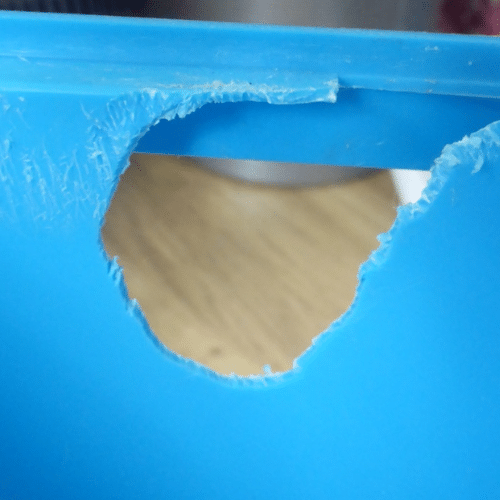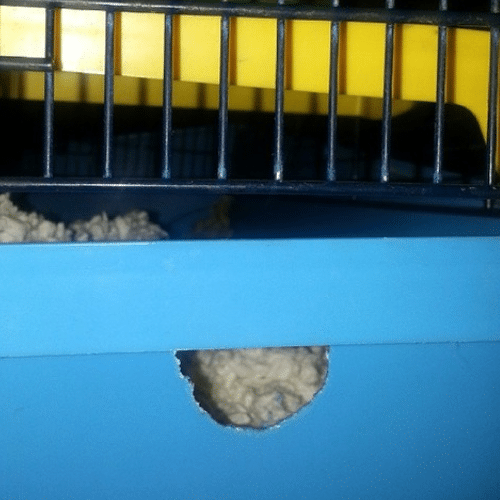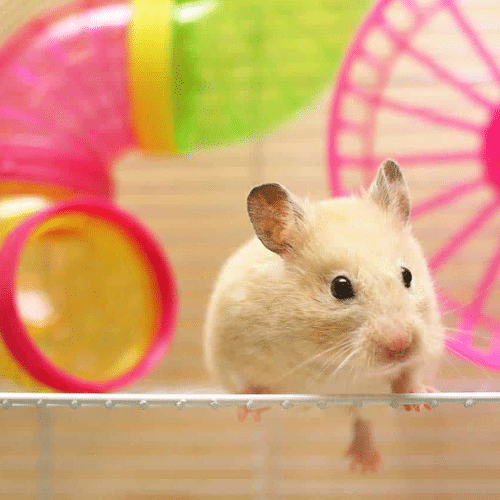Plastic is used for the construction of a significant number of the items found in a hamster’s cage. As anybody who has had a hamster can testify, these furry little rodents have teeth that may cause severe damage. But what about plastic durability? Can hamsters chew through plastic bins?
Yes, hamsters may destroy plastic bins and other types of plastic hamster housing. This phenomenon is not entirely unheard of, but it happens highly infrequently.
Hamsters have no problem gnawing on plastic and can entirely bite through the material if they want. Because hamsters’ teeth continue to develop throughout their whole lives, it is necessary for them to constantly nibble on something in order to prevent them from growing excessively huge.

If you have a very aggressive hamster that likes to bite through anything it sees, then it is advisable to place them in a glass enclosure with lots of wooden chews to nibble on in order to prevent them from destroying the plastic tank.
What Should You Do If Your Hamster Chew Through His/Her Cage?
Your hamster probably won’t try to get out of its cage unless the environment inside is really unpleasant. However, they will investigate their surroundings if they successfully cut a hole in a plastic cage.
In this scenario, your greatest worry is that your hamster will be lost or hurt, which is especially dangerous if you also have larger creatures in the house, like cats or dogs.

It’s possible that you’ve noticed your hamster chewing on the bars of his cage, which is especially likely if there aren’t any other objects in the cage that they can gnaw on more readily. On the other hand, the act of bar chewing is more likely to occur when your hamster is under stress, which is typically brought on by their enclosure being inadequately sized. However, biting on metal might lead to tooth damage in the long run.
How to Cope With the Issue?
The most effective way to fix any difficulties is to provide your hamster with something acceptable to chew on. This will eliminate the majority of the issues.
On the other hand, there are further actions that you may do to prevent your hamster from acquiring a preference for plastic.
You should get a cage with no plastic pieces (like an aquarium), and you should only use toys made of wood or other safe materials to gnaw on.
Ensure that the enclosure is kept clean. Once every few weeks, you need to ensure that you throw away any soiled bedding and thoroughly clean the hamster cage.
Make it a habit to conduct routine checks on the crate. Although a hamster can gnaw through plastic, this activity would be impossible for it to do in such a short amount of time. It is quite possible that you were not paying attention to what your pet was doing because it took them a considerable period of time to create a hole in the ground. To prevent this from happening, ensure that your pet and the state of the cage are always under observation.
It is imperative that you replace the plastic section of the hamster’s cage or any other sort of plastic as soon as possible if the hamster has bitten it. Hamsters are known to have sharp teeth. When buying a new cage, you might want to consider getting a glass tank instead of a metal one because it eliminates the possibility of further biting.
Are Hamsters Thrive Happily in Plastic Bins
There is a lot of controversy regarding plastic bin safety among hamster parents and veterinarians. On one side of the argument, it is claimed that hamsters will nibble through the plastic bins in order to either escape or get sick from eating the plastic (as discussed above).

On the other hand, one school of thought maintains that if you properly construct the bin cage, hamsters will be able to enjoy entire and healthy lives free from problems related to their living conditions. So, this choice is entirely up to you. You should contact your vet before making any decisions regarding your hamster housing.
Is Plastic in and of Itself Harmful for Hamsters
Chewing on plastic is dangerous for any animal, including the hamster, because plastic is not healthy for any animal, and the sharp edges of the plastic can cause internal damage. This is the other problem. Wire mesh of the appropriate size should be used to line the interior of the entire container as the recommended course of action.
FAQs
What's the average capacity of hamsters' plastic bins?
Clear large plastic containers ranging from 20 to 50 gallons in capacity are typically used to construct the majority of bin cages. These containers are sold in most retail and homeware stores. The contention here is that because hamsters chew everything, the chemicals in the plastic must be hazardous to their health.
Why Are People So Keen on Buying Bin Cages
The growing popularity of bin cages can be attributed to the fact that they provide more usable floor space while also being more cost-effective.
Additionally, the large plastic containers offer a solution to this issue since they are elevated to the point where your hamster will have plenty of areas to dig. You also can add another level to give them even more space to run about and exercise. You need to ensure sufficient room between the bedding on the second level and the lid so that the hamster cannot climb to the top of the cage and either get away or hurt themselves while attempting to do so.

Veterinarian (DVM, MS) Content Writer, Blogger, and WordPress Developer. Working as a pet/animal/bird/fish/reptile/wildlife writer for the past 7 years on many renowned platforms.




